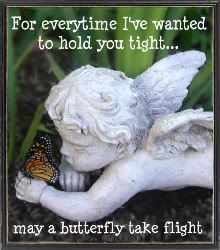 |
| Two released and "resting" before they fly high |
Raising Monarchs definitely has a learning curve. It all began one night in 2007 after I lost my last triplet. I sat in my backyard drinking a glass of wine and crying my eyes out. I sat and stared at our bare back wall....and then it hit me. I wanted to be able to show my children how often they were in my thoughts. My husband and I came up with the idea of a mural. So I painted their names across the wall and wrote underneath them, " For every time I've I wanted to hold you tight, may a butterfly take flight". Then I painted a butterfly anytime I felt like I needed to. For Jaxon's memorial service a few weeks later, we gave everyone the option of painting a butterfly also. And so it began, my love for butterflies...
A month or so later, I was walking my dogs and walked past a house that had butterflies just flying all around it. It was beautiful and I was in awe. So, I went to their door right then and there and asked her how she gets all these butterflies to stay at her house. She introduced me to passion vine and milkweed. I immediately (that day) went out and bought some. The rest is history!
I currently have over 40 milkweed plants in my yard and a large wall of passion vine. We have 5 butterfly cages to help protect the caterpillars from their natural predators (tachnid flies, wasps, birds). Although they all do not survive, many more do than if they are not protected. The screens on the cages need to be sanitized often and replaced about 2 times a year. If the butterflies that emerge show signs of the OE spore, they are unfortunately humanely (as possible) euthanized. I do this because 1) I can not release and dedicate a sick butterfly to an angel and 2) if I do the infected butterfly will spread the disease to the other butterflies and newly hatched caterpillars.
The life of the caterpillar:
Once I find a small in-star on the milkweed outside of the cage, I will move it to inside a cage where there is also milkweed. After about a week to 10 days it will be ready to "J hook" and make its chrysalis. It is quite a unique experience to watch. It takes about 2-3 minutes to shed its top layer of skin , revealing the beautiful green and gold chrysalis.
"If nothing ever changed...there would be no butterflies" - author unknown
After 1-3 weeks (depending on the temperature) a butterfly will emerge. After it dried its wings, but before it is ready to fly, I take the butterfly and place him/her on an angel figurine and take photos. Then it dedicated and released. Normally, the butterflies that are released come back and visit us and help to re-populate my supply. We always have lots of butterflies flying around.
The other little things that come with raising Monarchs:
Aphids - yuck. Although harmless, these little buggers are gross. They multiply at an amazing rate and really gross me out.
 |
| Yellow aphids |
However, when there are aphids there are also lots of....
Lady bugs - these well known beauties love to eat aphids. They also lay their eggs on the milkweed so their larvae has an ample food supply once hatched. The lady bug larvae also go through several in-stars, shedding their skin to accommodate their larger bodies.
 |
| lady bug larvae |
 |
| several lady bug larvae having "lunch" |
 |
| The final in-star |
Tachnid fly: these flies are a pest. The adult fly will lay its eggs inside a caterpillar. The egg will then hatch into a maggot. The maggot will eat the inside of the caterpillar and it will eventually die. I really do not like tachind flies. You can tell the difference from the regular house fly because of its coloring. Tachnids are dull in color, just grey and black with very large red eyes.
 |
| Mid body you can see the scar where the egg was laid inside its body. |
 |
| A Monarch infected by the tachnid as a caterpillar. It died shortly after it made its chrysalis. |
 |
Tachnid fly
|
Wasps: My other least favorite pest. These buggers are smart little ones and can usually dig their way into a cage to a buffet of caterpillars. Half the year they will eat nectar, like bees. However, the other half the time they need extra protein to lay eggs and that is when they go for my lovely caterpillars.
 |
| Wasp outside of one of my cages "trying" to get in. |
|
|
|
OE spore: this nasty microscopic parasite live on the milkweed and after the caterpillar eats it, it becomes infected. If it has a higher amount of the OE spore in its gut, it will die. This either happens when it is still a caterpillar (black death), after it is in chrysalis form or after it emerges or tries to emerge (deformed). Some do emerge fine after contracting this parasite but then spread the parasite onto the milkweed thus infecting the next generation.
 |
| A chrysalis infected with the OE spore. The butterfly is dead and will never emerge. |
 |
| The caterpillar on the right is heavily infected with the OE spore. Its skin is blotchy and dark. The lines are not distinct. It died shortly after this photo was taken from the "black death". |
And if they survive all that, we get this...
 |
| Male Monarch right before he was photographed, dedicated and released. |
 |
| Three Monarchs resting prior to flying away |
 |
| Female Monarch | | | | | |
|


























